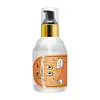What's inside
What's inside
 Key Ingredients
Key Ingredients

No key ingredients
 Benefits
Benefits

 Concerns
Concerns

 Ingredients Side-by-side
Ingredients Side-by-side

Cyclopentasiloxane
EmollientDimethicone
EmollientDisiloxane
Skin ConditioningParfum
MaskingWater
Skin ConditioningHydrolyzed Collagen
EmollientArgania Spinosa Kernel Oil
EmollientHippophae Rhamnoides Fruit Oil
Skin ProtectingOenothera Biennis Oil
EmollientChamomilla Recutita Flower Oil
MaskingButylene Glycol
HumectantPanax Ginseng Root Extract
EmollientGelatin
Hydrolyzed Keratin
HumectantAvena Sativa Protein Extract
Skin ConditioningOriganum Vulgare Extract
Skin ConditioningThymus Vulgaris Flower/Leaf/Stem Extract
Skin ConditioningRosmarinus Officinalis Leaf Extract
AntimicrobialLavandula Angustifolia Flower Extract
CleansingHydrolyzed Wheat Protein
Skin ConditioningHydrolyzed Corn Protein
Skin ConditioningHydrolyzed Soy Protein
HumectantCaprylyl Glycol
Emollient1,2-Hexanediol
Skin ConditioningIllicium Verum Fruit Extract
PerfumingCyclopentasiloxane, Dimethicone, Disiloxane, Parfum, Water, Hydrolyzed Collagen, Argania Spinosa Kernel Oil, Hippophae Rhamnoides Fruit Oil, Oenothera Biennis Oil, Chamomilla Recutita Flower Oil, Butylene Glycol, Panax Ginseng Root Extract, Gelatin, Hydrolyzed Keratin, Avena Sativa Protein Extract, Origanum Vulgare Extract, Thymus Vulgaris Flower/Leaf/Stem Extract, Rosmarinus Officinalis Leaf Extract, Lavandula Angustifolia Flower Extract, Hydrolyzed Wheat Protein, Hydrolyzed Corn Protein, Hydrolyzed Soy Protein, Caprylyl Glycol, 1,2-Hexanediol, Illicium Verum Fruit Extract
Water
Skin ConditioningCetearyl Alcohol
EmollientAmodimethicone
Cetyl Esters
EmollientBehentrimonium Chloride
PreservativeParfum
MaskingPyrus Malus Fruit Extract
Skin ConditioningIsopropyl Alcohol
SolventTrideceth-6
EmulsifyingArgania Spinosa Kernel Oil
EmollientNiacinamide
SmoothingPyridoxine Hcl
Skin ConditioningHexyl Cinnamal
PerfumingChlorhexidine Dihydrochloride
AntimicrobialCitric Acid
BufferingCetrimonium Chloride
AntimicrobialSaccharum Officinarum Extract
MoisturisingBenzyl Alcohol
PerfumingLinalool
PerfumingAmyl Cinnamal
PerfumingTocopherol
AntioxidantHydroxypropyltrimonium Lemon Protein
HumectantCI 19140
Cosmetic ColorantCI 15985
Cosmetic ColorantPhenoxyethanol
PreservativeCitrus Limon Peel Extract
EmollientLeuconostoc/Radish Root Ferment Filtrate
AntimicrobialCamellia Sinensis Leaf Extract
AntimicrobialWater, Cetearyl Alcohol, Amodimethicone, Cetyl Esters, Behentrimonium Chloride, Parfum, Pyrus Malus Fruit Extract, Isopropyl Alcohol, Trideceth-6, Argania Spinosa Kernel Oil, Niacinamide, Pyridoxine Hcl, Hexyl Cinnamal, Chlorhexidine Dihydrochloride, Citric Acid, Cetrimonium Chloride, Saccharum Officinarum Extract, Benzyl Alcohol, Linalool, Amyl Cinnamal, Tocopherol, Hydroxypropyltrimonium Lemon Protein, CI 19140, CI 15985, Phenoxyethanol, Citrus Limon Peel Extract, Leuconostoc/Radish Root Ferment Filtrate, Camellia Sinensis Leaf Extract
 Reviews
Reviews

Ingredients Explained
These ingredients are found in both products.
Ingredients higher up in an ingredient list are typically present in a larger amount.
You may know this ingredient as argan oil. Argan Oil has antioxidant, hydrating, and soothing properties.
Studies have shown argan oil can help fight again radical damage from the sun. This makes it effective at preventing hyperpigmentation.
Large amounts of vitamin E found in argan oil helps the skin retain water. Argan oil also contains fatty acids such as linoleic acid, oleic acid, and palmitic acid. It is also a good source of lipids.
Another benefit of argan oil is skin-soothing. It can help reduce inflammation-related skin symptoms.
Argan Oil is effective at regulating sebum production in pores. This can make it effective at treating hormonal acne.
Traditionally, argan oil was used for its antibacterial and antifungal properties. However, argan oil contains fatty acids that may make it not fungal-acne safe.
Argan Trees are native to Morocco.
Learn more about Argania Spinosa Kernel OilParfum is a catch-all term for an ingredient or more that is used to give a scent to products.
Also called "fragrance", this ingredient can be a blend of hundreds of chemicals or plant oils. This means every product with "fragrance" or "parfum" in the ingredients list is a different mixture.
For instance, Habanolide is a proprietary trade name for a specific aroma chemical. When used as a fragrance ingredient in cosmetics, most aroma chemicals fall under the broad labeling category of “FRAGRANCE” or “PARFUM” according to EU and US regulations.
The term 'parfum' or 'fragrance' is not regulated in many countries. In many cases, it is up to the brand to define this term.
For instance, many brands choose to label themselves as "fragrance-free" because they are not using synthetic fragrances. However, their products may still contain ingredients such as essential oils that are considered a fragrance by INCI standards.
One example is Calendula flower extract. Calendula is an essential oil that still imparts a scent or 'fragrance'.
Depending on the blend, the ingredients in the mixture can cause allergies and sensitivities on the skin. Some ingredients that are known EU allergens include linalool and citronellol.
Parfum can also be used to mask or cover an unpleasant scent.
The bottom line is: not all fragrances/parfum/ingredients are created equally. If you are worried about fragrances, we recommend taking a closer look at an ingredient. And of course, we always recommend speaking with a professional.
Learn more about ParfumWater. It's the most common cosmetic ingredient of all. You'll usually see it at the top of ingredient lists, meaning that it makes up the largest part of the product.
So why is it so popular? Water most often acts as a solvent - this means that it helps dissolve other ingredients into the formulation.
You'll also recognize water as that liquid we all need to stay alive. If you see this, drink a glass of water. Stay hydrated!
Learn more about Water